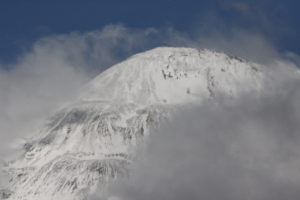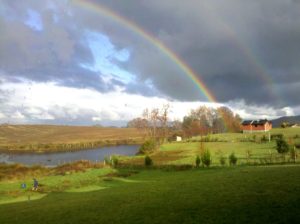
Imagine – fair weather for almost a whole week, with no winds to ruffle our feathers! It was even calm enough to camp on a beach last night after taking one of the very efficient ferries (WA state take notice – there is a 10 minute wait at most…) from the mainland to Chiloe. Our camping made it very easy to participate in the “Lights Out Around the World” energy awareness campaign ; we  quietly watched the sun go down over the Pacific before snuggling into our cozy tarp tent without an earth-light in sight as the Milky Way and the Southern Cross reigned supreme.
quietly watched the sun go down over the Pacific before snuggling into our cozy tarp tent without an earth-light in sight as the Milky Way and the Southern Cross reigned supreme.
We flew back north from Punta Arenas and, after recovering our car in Puerto Montt, we headed north to the southern end of Lake Llanquihue in the Lakes District of Chile. Val had a 3-day marine conference in Puerto Varas, a town dominated by towering Volcan Osorono. About 200 cetacean scientists and students from around the world gathered to take stock of the Living Whales in the Southern Ocean. Val heard reports on Southern Right whales which hug the beaches of southern Argintina and Blue Whales which are hard to find and hard to study, plus much more. It was a good opportunity for Leslie to explore the picturesque town with its German colonial architecture and superb examples of indigenous basketry, textiles and woodworking. One evening we took a walking tour of many of the shingled houses and photographed some on the hilly Paseo Patrimonial. Some homes are in prime condition (such as the Parque Pumilin headquarters), and others, although charming in a rustic way, are in need of some restoration, but all are surrounded by the ever-present roses of this colorful town.
Then it was back to Chiloe for more volunteer work on the wind farm project and on educational outreach. We revisited the Mar Brava beach site and took more photographs (this time with GPS readings). Val has been writing a computer program that can take any photo that was taken at a known place and in a known direction and superimpose on the scene the windmills that would be built if the Mar Brava project goes forward with the windmill locations as currently specified. Here is an example of a photo we took at the north end of the Mar Brava beach and that photo with computed windmills for that range and perspective.
FINALLY the weather cooperated enough to contract with two gregarious local fishermen, Pedro and Francisco, to take us out in their boat so that we could make some necessary sound measurements. We dropped the hydrophones (which Val has been carrying for months) over the side of the boat, recorded the sounds, and took some more coordinates. A surprise fringe benefit was going on a side trip to some local islands to see some wary sea lions with a vulture standing guard in the background. We also watched many cormorants and pelicans interacting nearby.
Then, back on land at Punihuil, Leslie talked in more detail than previously with Katya of Pinguinera Punihuil about the educational needs of Fundacion Otway, the nonprofit organization which has worked for years to protect the nearby breeding grounds of the many Megallanic and a few near-extinct Humboldt penguins. In April, we will be busy at Helen’s house, not only dog and house sitting; Val will be writing a paper about noise levels and visual impacts of the proposed wind farm project.  Coordinating with Katya, Leslie plans to produce interactive educational materials for children visiting the penguin sanctuary. She also has tentative plans to work with Barbara, Elsa and Laura, who are with Centre de Conservacion Cetaecea, on other educational outreach projects for the area’s diverse populations.
Coordinating with Katya, Leslie plans to produce interactive educational materials for children visiting the penguin sanctuary. She also has tentative plans to work with Barbara, Elsa and Laura, who are with Centre de Conservacion Cetaecea, on other educational outreach projects for the area’s diverse populations.
Staying in government-supported agroturismos has been a favorite type of accommodation of ours in Chile. We have enjoyed the family atmosphere, the friendly proprietors, the connection to gardening or farming, and the opportunity to support local, organic cooks. We revisited a school (Esquela Pulelo #321) in Chiloe which has been turned partly into an agroturismo hostel, and smiling Ana greeted us warmly. At breakfast the next morning we learned that she runs the school’s office next door, so off Leslie went, with Ana as tour guide. It was fun to meet the teachers and most of the 66 students, grouped in 3 levels: grades 1-3, grades 4-6, and grades 7-9. Older students go to a high school about an hour away in either Ancud or across the water in Puerto Montt. This visit was certainly a unique view of a small Chilean school in rural Chiloe.
Our research involving the wind farm project has led us to many interesting individuals. Gisela was one of those, and we visited her on her family’s agroturismo farm, Norte del Sur, in the northwestern corner of Chiloe. We tried to talk with her (in our still-problematic Spanish) about her efforts to stop the wind farm project by coordinating several environmental organizations. We also enjoyed a typical Chilean stew for lunch, interrupted by a huge flock of noisy parrots flying overhead (click here for video to hear the racket.) Later on, we snacked on crisp apples from the family’s orchard, and tasted a sweet marmalada made of plums and rhubarb by Gisela’s mother – perfect for our newly-purchased quinoa bread!
[shashin type=”album” id=”31″ size=”small” crop=”n” columns=”max” caption=”y” order=”date” position=”center”]
















Stormy
3 Apr 2012It’s good to hear that you are getting some good weather with no wind and no rain! I bet the stars are very different than what you’re used to — no Big Dipper or Cassiopeia.